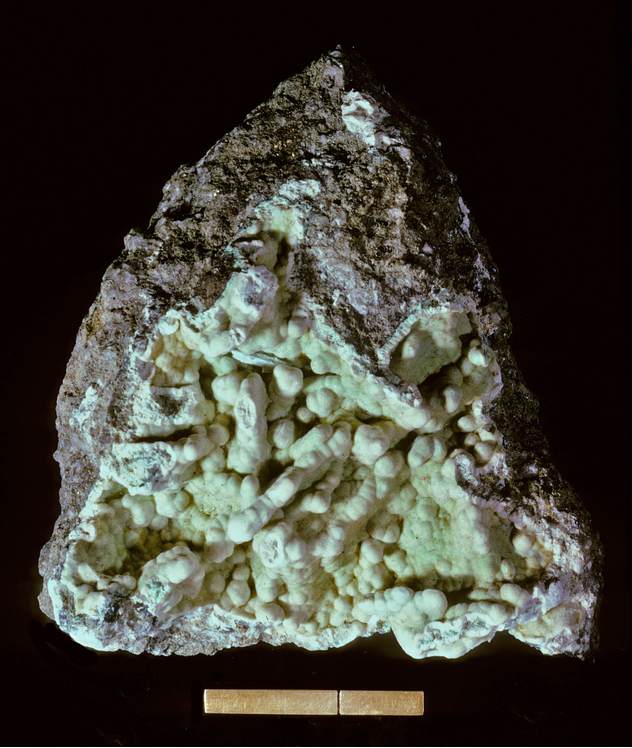Liskeardite
A valid IMA mineral species - grandfathered
This page is currently not sponsored. Click here to sponsor this page.
About Liskeardite
Formula:
[(Al,Fe)32(AsO4)18(OH)42(H2O)22] · 52H2O
Formerly thought to be (Al,Fe3+)3(AsO4)(OH)6.5H2O.
Colour:
White, greenish, bluish, brownish; colourless in transmitted light.
Crystal System:
Monoclinic
Name:
Named after the community of Liskeard, Cornwall, England, UK, near the type locality.
A secondary mineral resulting from the oxidation of arsenic-bearing sulfides.
Chemically similar to bettertonite.
Chemically similar to bettertonite.
Unique Identifiers
Mindat ID:
2416
Long-form identifier:
mindat:1:1:2416:3
GUID
(UUID V4):
(UUID V4):
6755c4ad-3d80-4b13-9af6-661b985885d0
IMA Classification of Liskeardite
Approved, 'Grandfathered' (first described prior to 1959)
IMA Formula:
(Al,Fe)32(AsO4)18(OH)42(H2O)22 · 52H2O
First published:
1878
Type description reference:
Classification of Liskeardite
8.DF.10
8 : PHOSPHATES, ARSENATES, VANADATES
D : Phosphates, etc. with additional anions, with H2O
F : With only medium-sized cations, (OH,etc.):RO4 > 3:1
8 : PHOSPHATES, ARSENATES, VANADATES
D : Phosphates, etc. with additional anions, with H2O
F : With only medium-sized cations, (OH,etc.):RO4 > 3:1
42.1.1.1
42 : HYDRATED PHOSPHATES, ETC.CONTAINING HYDROXYL OR HALOGEN
1 : A3(XO4)Zq·xH2O
42 : HYDRATED PHOSPHATES, ETC.CONTAINING HYDROXYL OR HALOGEN
1 : A3(XO4)Zq·xH2O
20.9.14
20 : Arsenates (also arsenates with phosphate, but without other anions)
9 : Arsenates of Fe
20 : Arsenates (also arsenates with phosphate, but without other anions)
9 : Arsenates of Fe
Mineral Symbols
As of 2021 there are now IMA–CNMNC approved mineral symbols (abbreviations) for each mineral species, useful for tables and diagrams.
| Symbol | Source | Reference |
|---|---|---|
| Lsk | IMA–CNMNC | Warr, L.N. (2021). IMA–CNMNC approved mineral symbols. Mineralogical Magazine, 85(3), 291-320. doi:10.1180/mgm.2021.43 |
Pronunciation of Liskeardite
Pronunciation:
| Play | Recorded by | Country |
|---|---|---|
| Jolyon Ralph | United Kingdom |
Physical Properties of Liskeardite
Transparency:
Translucent
Colour:
White, greenish, bluish, brownish; colourless in transmitted light.
Optical Data of Liskeardite
Type:
Biaxial (+)
RI values:
nα = 1.661 nβ = 1.675 nγ = 1.689
2V:
Measured: 90° , Calculated: 88°
Max Birefringence:
δ = 0.028

Image shows birefringence interference colour range (at 30µm thickness)
and does not take into account mineral colouration.
and does not take into account mineral colouration.
Surface Relief:
High
Dispersion:
r < v strong
Chemistry of Liskeardite
Mindat Formula:
[(Al,Fe)32(AsO4)18(OH)42(H2O)22] · 52H2O
Formerly thought to be (Al,Fe3+)3(AsO4)(OH)6.5H2O.
Formerly thought to be (Al,Fe3+)3(AsO4)(OH)6.5H2O.
Crystallography of Liskeardite
Crystal System:
Monoclinic
Cell Parameters:
a = 24.576(5) Å, b = 7.754(2) Å, c = 24.641(5) Å
β = 90.19(1)°
β = 90.19(1)°
Ratio:
a:b:c = 3.169 : 1 : 3.178
Unit Cell V:
4,695.62 ų (Calculated from Unit Cell)
Morphology:
Massive, crusts with a radial-fibrous structure.
Comment:
space group I2, crystal structure was determined using synchrotron data collected on a 2 μm diameter fibre at 100 K.
Crystal Structure
Load
Unit Cell | Unit Cell Packed
2x2x2 | 3x3x3 | 4x4x4
Unit Cell | Unit Cell Packed
2x2x2 | 3x3x3 | 4x4x4
Show
Big Balls | Small Balls | Just Balls | Spacefill
Polyhedra Off | Si Polyhedra | All Polyhedra
Remove metal-metal sticks
Big Balls | Small Balls | Just Balls | Spacefill
Polyhedra Off | Si Polyhedra | All Polyhedra
Remove metal-metal sticks
Display Options
Black Background | White Background
Perspective On | Perspective Off
2D | Stereo | Red-Blue | Red-Cyan
Black Background | White Background
Perspective On | Perspective Off
2D | Stereo | Red-Blue | Red-Cyan
View
CIF File Best | x | y | z | a | b | c
CIF File Best | x | y | z | a | b | c
Rotation
Stop | Start
Stop | Start
Labels
Console Off | On | Grey | Yellow
Console Off | On | Grey | Yellow
Data courtesy of the American Mineralogist Crystal Structure Database. Click on an AMCSD ID to view structure
| ID | Species | Reference | Link | Year | Locality | Pressure (GPa) | Temp (K) |
|---|---|---|---|---|---|---|---|
| 0020528 | Liskeardite | Grey I E, Mumme W G, Macrae C M, Caradoc-Davies T, Price J R, Rumsey M S, Mills S J (2013) Chiral edge-shared octahedral chains in liskeardite, [(Al,Fe)32(AsO4)18(OH)42(H2O)22] *52H2O, an open framework mineral with a pharmacoalumite-related structure Mineralogical Magazine 77 3125-3135 | 2013 | Marke Valley mine, Liskeard District, Cornwall, UK | 0 | 100 |
CIF Raw Data - click here to close
X-Ray Powder Diffraction
Powder Diffraction Data:
| d-spacing | Intensity |
|---|---|
| 17.6 Å | (100) |
| 12.2 Å | (60) |
| 8.65 Å | (80) |
| 7.85 Å | (65) |
| 7.44 Å | (60) |
| 5.66 Å | (20) |
| 4.76 Å | (20) |
| 4.56 Å | (20) |
| 4.25 Å | (40) |
| 3.95 Å | (40) |
| 3.44 Å | (20) |
| 3.33 Å | (100) |
| 3.22 Å | (40) |
| 3.12 Å | (20) |
| 2.85 Å | (40) |
| 2.78 Å | (40) |
| 2.59 Å | (40) |
| 2.47 Å | (20) |
| 2.37 Å | (60) |
| 2.28 Å | (40) |
| 2.24 Å | (40) |
Comments:
Data from Guillemin (1952) for specimen from Cap Garonne.
Type material gives a poor X-ray pattern.
Type material gives a poor X-ray pattern.
Geological Environment
Paragenetic Mode(s):
| Paragenetic Mode | Earliest Age (Ga) |
|---|---|
| Stage 7: Great Oxidation Event | <2.4 |
| 47a : [Near-surface hydration of prior minerals] | |
| 47d : [Arsenates, antimonates, selenates, bismuthinates] |
Type Occurrence of Liskeardite
General Appearance of Type Material:
Occurs as a layer, several millimeters thick, with uniform, fibrous structure, coating quartz in pockets.
Place of Conservation of Type Material:
The Natural History Museum, London, England, UK - #50821.
Associated Minerals at Type Locality:
Reference:
Maskelyne, N.S. (1878) A new mineral. Nature: 18: 426-426.
Other Language Names for Liskeardite
German:Liskeardit
Spanish:Liskeardita
Common Associates
Associated Minerals Based on Photo Data:
| 3 photos of Liskeardite associated with Scorodite | Fe3+AsO4 · 2H2O |
| 1 photo of Liskeardite associated with Chalcophyllite | Cu18Al2(AsO4)4(SO4)3(OH)24 · 36H2O |
| 1 photo of Liskeardite associated with Cyanotrichite | Cu4Al2(SO4)(OH)12 · 2H2O |
Related Minerals - Strunz-mindat Grouping
| 8.DF. | Kernowite | Cu2Fe(AsO4)(OH)4 · 4H2O |
| 8.DF. | Wiperamingaite | NaCaFe3+Al(PO4)F5(OH) · H2O |
| 8.DF.05 | Hotsonite | Al11(SO4)3(PO4)2(OH)21 · 16H2O |
| 8.DF.10 | Bolivarite | Al2(PO4)(OH)3 · 4-5H2O |
| 8.DF.10 | Evansite | Al3(PO4)(OH)6 · 6H2O |
| 8.DF.10 | Rosièresite | (Pb, Cu, Al, P, O, H) |
| 8.DF.15 | Rusakovite | (Fe3+,Al)5(VO4,PO4)2(OH)9 · 3H2O |
| 8.DF.20 | Liroconite | Cu2Al(AsO4)(OH)4 · 4H2O |
| 8.DF.25 | Sieleckiite | Cu3Al4(PO4)2(OH)12 · 2H2O |
| 8.DF.30 | Chalcophyllite | Cu18Al2(AsO4)4(SO4)3(OH)24 · 36H2O |
| 8.DF.35 | Parnauite | Cu9(AsO4)2(SO4)(OH)10 · 7H2O |
| 8.DF.40 | Gladiusite | Fe2(Fe,Mg)4(PO4)(OH)11(H2O) |
| 8.DF.50 | Forêtite | Cu2Al2(AsO4)(OH,O,H2O)6 |
Other Information
Health Risks:
No information on health risks for this material has been entered into the database. You should always treat mineral specimens with care.
Internet Links for Liskeardite
mindat.org URL:
https://www.mindat.org/min-2416.html
Please feel free to link to this page.
Please feel free to link to this page.
Search Engines:
External Links:
Mineral Dealers:
References for Liskeardite
Localities for Liskeardite
Locality List
 - This locality has map coordinates listed.
- This locality has map coordinates listed.
 - This locality has estimated coordinates.
ⓘ - Click for references and further information on this occurrence.
? - Indicates mineral may be doubtful at this locality.
- This locality has estimated coordinates.
ⓘ - Click for references and further information on this occurrence.
? - Indicates mineral may be doubtful at this locality.
 - Good crystals or important locality for species.
- Good crystals or important locality for species.
 - World class for species or very significant.
(TL) - Type Locality for a valid mineral species.
(FRL) - First Recorded Locality for everything else (eg varieties).
- World class for species or very significant.
(TL) - Type Locality for a valid mineral species.
(FRL) - First Recorded Locality for everything else (eg varieties).
All localities listed without proper references should be considered as questionable.
France | |
| Guillemin (1952) |
Germany | |
| rruff.geo.arizona.edu (n.d.) |
Russia | |
| Bortnikova et al. (2017) |
UK | |
| |
| |
| Bulletin de la Société française de Minéralogie et de Cristallographie (1952) |
| Golley et al. (1995) +1 other reference |
Quick NavTopAbout LiskearditeUnique IdentifiersIMA Classification Classification Mineral SymbolsPronunciation Physical Properties Optical Data Chemistry Crystallography Crystal StructureX-Ray Powder DiffractionGeological EnvironmentType Occurrence Other LanguagesCommon AssociatesStrunz-MindatOther InformationInternet Links References Localities Locality List






 symbol to view information about a locality.
The
symbol to view information about a locality.
The 



Marke Valley Mine, Upton Cross, Linkinhorne, Cornwall, England, UK